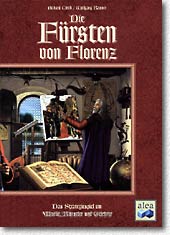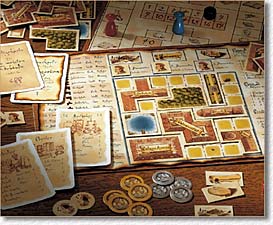
Princes of Florence
(Die Fürsten von Florenz)
Publisher: ALEA, Ravensburger
Author: Richard Ulrich and Wolfgang Kramer
Tested: Basic rules (published 2000)
Tester: Walter Sorger (translation by Aaron Haag)
The game: Each player represents a prince (in Florence or any other medieval
city state) who has the task to bring civil quality ("prestige") to their
court. On the one hand they can do this by developing buildings (from universities to
chapels) and landscapes (parks, lakes and forests), on the other hand by attracting
professionals (builders and jugglers), which foster a pleasant life at the court. Also
included is the granting of civil rights. Furthermore the player can increase the
prestige of their court directly or indirectly by the acquisition of prestige and bonus
cards.  Finally, the largest increase in prestige is
achieved by the artists and scholars of the court, which, in the pleasant
surroundings and equipped with rights, are inspired by the company of people and the
entertainment of jugglers to create works of art and science. In the first game
phase the decisions of the players are made in competition to each other (by
auctions), in the second phase absolutely autonomously in fixed order. After seven
rounds the game is over and the player who has gained the most points of prestige
wins. The game has a busy, eager, but nevertheless peaceful character. Coincidences
and strokes of fate are avoided. The consequences of the auctions are moderate,
since eventually everyone has a successful bid, and each acquired object can be made
to fit a plan. The effect of the cards is manageable: all have approximately the
same quality of usefulness and one may chose the most suitable card from the top
five of a deck.
Finally, the largest increase in prestige is
achieved by the artists and scholars of the court, which, in the pleasant
surroundings and equipped with rights, are inspired by the company of people and the
entertainment of jugglers to create works of art and science. In the first game
phase the decisions of the players are made in competition to each other (by
auctions), in the second phase absolutely autonomously in fixed order. After seven
rounds the game is over and the player who has gained the most points of prestige
wins. The game has a busy, eager, but nevertheless peaceful character. Coincidences
and strokes of fate are avoided. The consequences of the auctions are moderate,
since eventually everyone has a successful bid, and each acquired object can be made
to fit a plan. The effect of the cards is manageable: all have approximately the
same quality of usefulness and one may chose the most suitable card from the top
five of a deck.
Playing time: Rule explanation approx. 10 minutes, playing time about 1 ½
hours
Similar games: Schoko & Co.
Westpark Gamers' opinion: A very balanced strategy game, without chaotic
elements, with a nice game idea and a functional design. Whatever the others choose to
do, it is always possible, "to have a plan". Whether one decides to count on
eagerly established buildings, the development of ones landscape, or the inspiration of
artists or the effect of cards, from all of these decisions winning strategies can be
derived, and it is not yet clear to us which one is the best. (Our artist Moritz
confessed that after our first game in his dreams the following night he felt under
pressure to complete more works of art!). We missed some player interactions during the
second game phase where all players act autonomously. Everyone struggles by himself and
calculates whether is is worthwhile to outperform another players in terms of the number
of works of art or if it is better to wait for the next round.
Walter's rating: 8 of 10 (because of the possibility to plan ahead)
Westpark Gamers' rating: 8.6
 Finally, the largest increase in prestige is
achieved by the artists and scholars of the court, which, in the pleasant
surroundings and equipped with rights, are inspired by the company of people and the
entertainment of jugglers to create works of art and science. In the first game
phase the decisions of the players are made in competition to each other (by
auctions), in the second phase absolutely autonomously in fixed order. After seven
rounds the game is over and the player who has gained the most points of prestige
wins. The game has a busy, eager, but nevertheless peaceful character. Coincidences
and strokes of fate are avoided. The consequences of the auctions are moderate,
since eventually everyone has a successful bid, and each acquired object can be made
to fit a plan. The effect of the cards is manageable: all have approximately the
same quality of usefulness and one may chose the most suitable card from the top
five of a deck.
Finally, the largest increase in prestige is
achieved by the artists and scholars of the court, which, in the pleasant
surroundings and equipped with rights, are inspired by the company of people and the
entertainment of jugglers to create works of art and science. In the first game
phase the decisions of the players are made in competition to each other (by
auctions), in the second phase absolutely autonomously in fixed order. After seven
rounds the game is over and the player who has gained the most points of prestige
wins. The game has a busy, eager, but nevertheless peaceful character. Coincidences
and strokes of fate are avoided. The consequences of the auctions are moderate,
since eventually everyone has a successful bid, and each acquired object can be made
to fit a plan. The effect of the cards is manageable: all have approximately the
same quality of usefulness and one may chose the most suitable card from the top
five of a deck.